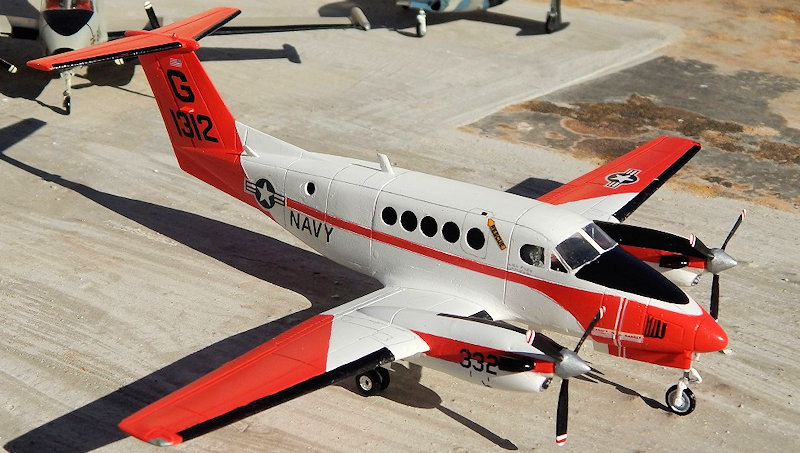
Rareplanes 1/72 Beechcraft UC-12B
| KIT #: | |
| PRICE: | £6.00 |
| DECALS: | None |
| REVIEWER: | Carmel J. Attard |
| NOTES: | Vacuform with metal parts |

| HISTORY |
The Beechcraft Super King Air family is part of a line of twin turboprop aircraft produced by Beechcraft. The King Air line comprises a number of model series that fall into four families: the Model 90 series, Model 100 series (these models comprising the King Airfamily), Model 200 series and Model 300 series. The latter two models were originally marketed as the "Super King Air" family, but the "Super" was dropped in 1996.
The Super King Air family has been in continuous production since 1974,the longest production run of any civilian turboprop aircraft in its class. It has outlasted all of its previous competitors and as of 2009 the only other aircraft in its class is the Piaggio Avanti. At the present, the BT200GT, BT200CGT and the larger B300 and B300C, are the production models. Special mission derivative versions of these models are also available for order.
Military variants
The C-12 also known as Huron, is a twin turboprop passenger and cargo aircraft, is the military version of the Beachcraft Super King Air. The C-12 aircraft, manufactured by Raytheon Aircraft Company (RAC) (formerly Beech Aircraft Corporation), is a high-performance, fixed-wing, T-tail, pressurized, twin-engine turboprop that accommodates places for a pilot, co-pilot, and passengers. Two Pratt and Whitney PT6A-41/42/65 turbo prop engines power it. The Government’s C-12 aircraft fleet is similar to the Beech Super King Air 200 & 1900C, which is operated extensively around the world by many private and commercial users. The aircraft provides operational support for military bases, sites, and fleet and shore units.
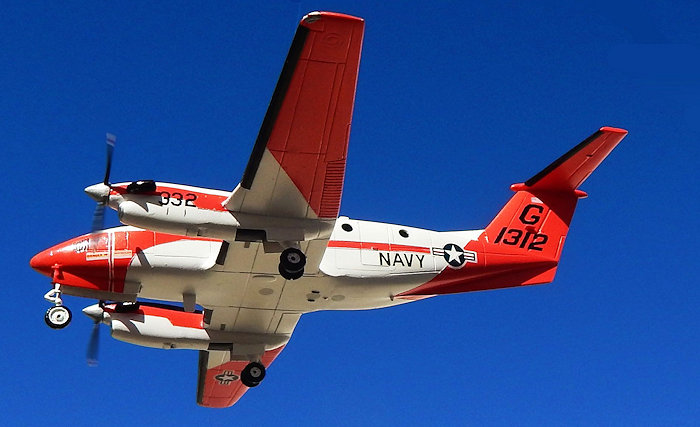 The C-12F can carry up to eight passengers and has a cargo capacity of
56 cubic feet. It can be used to transport patients on medical
evacuation litters. There are 19 C-12Fs in the active duty Air Force.
Delivery began in May 1984 and was completed by the end of that year.
The Air Force acquired the C-12F at the direction of Congress to support
the Defence Attach and Security Assistance Offices.
The C-12F can carry up to eight passengers and has a cargo capacity of
56 cubic feet. It can be used to transport patients on medical
evacuation litters. There are 19 C-12Fs in the active duty Air Force.
Delivery began in May 1984 and was completed by the end of that year.
The Air Force acquired the C-12F at the direction of Congress to support
the Defence Attach and Security Assistance Offices.
The aircraft provides on-call, rapid response, modern air transport for high priority supply and movement of key personnel. Specifically, it is used for VIP transport or to deliver repair parts; equipment; and technical, crash investigation, and accident investigation teams wherever needed. Its support role also includes such functions as range clearance, medical evacuation, and administrative movement of personnel, transportation connections, and courier flights.
The United States Army, Air Force, Navy and Marine Corps have all flown versions of the Super King Air 200. As noted above some have been "off-the-shelf" civil versions, but the majority have been purpose-built for the military and were treated by Beechcraft and the FAA as a separate series, the A200 series. A significant minority of military versions are known purely by their military designations, with no FAA model designations being assigned to them, although they do have basically-equivalent civilian model counterparts. The military designation varies from service to service, but most are called C-12 Huron or UC-12. These are used for personnel transport. The Army also operates the RC-12 Guardrail series of aircraft for military intelligence missions.
The first C-12A models entered service with the U.S. Army in 1974 and was used as a liaison and general personnel transport. The aircraft was essentially an "off-the-shelf" Super King Air 200, powered by the type's standard Pratt and Whitney Canada PT6A-41 engines.
The U.S. Navy followed suit in 1979, ordering a version of the
Super King Air A200C (modified with a 52 inch by 52 inch cargo door from
the Super King Air 200C), designating it the UC-12B, for logistics
support between Naval and Marine Corps air stations, air facilities, and
other activities, both in CONUS and overseas. The cabin can readily
accommodate cargo, passengers or both. It is also equipped to
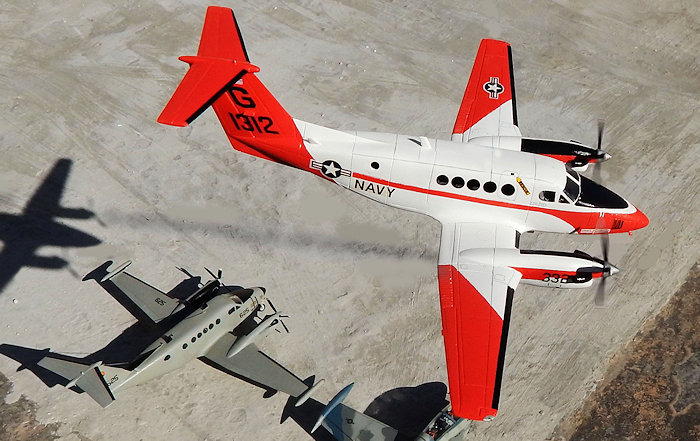 accept
litter patients in medical evacuation missions. Through 1982, the Navy
ordered 64 of these aircraft.
accept
litter patients in medical evacuation missions. Through 1982, the Navy
ordered 64 of these aircraft.
A U.S. Air Force variant of the plane for surveillance roles primarily over Afghanistan and Iraq was the MC-12W Liberty. For that variant, Beechcraft built the basic plane and then sent it to Greenville, Texas, where sophisticated intelligence, surveillance and reconnaissance (ISR) equipment was installed by L-3 Communications Missions Integration L-3. As of 2013 the Liberty program had exceeded 300,000 combat flying hours. The MC-12W was rushed into combat as a supplemental surveillance and signals intelligence asset; since its first combat mission on 10 June 2009, the aircraft flew 400,000 combat hours in 79,000 combat sorties, aiding in the kill or capture of “more than 8,000 terrorists” and uncovering 650 weapons caches. With its roles taken over by the growing MQ-9 Reaper fleet, the Air Force decided to divest itself of the 41 Liberty aircraft and turn them over to the U.S. Army and U.S. Special Operations Command. which will be completed by October 2015. The Air Force's final MC-12W deployment in support of Operation Enduring Freedom ended on 13 October 2015.
| THE KIT |
The kit comes in a sturdy box of the type supplied by Rare Plane.
The box cover depicts a side view of a UC-12B Huron in US Navy markings
circa 1984. The kit basically contains detailed vacuum formed styrene
mouldings which consist of fuselage halves, main wing parts and tail planes,
engine nacelles which come in two half each, front and rear bulkheads,
cockpit office parts and clear styrene canopy. Unlike previous kit I had of
same model where the canopy was missing this one had two, one of which was
slightly
 damaged and the other I have used on the model. This one covered
the whole of the cockpit area. There are metal parts that include three oleo
legs, pair of three blade props complete with spinner. The wheels are also
in white metal. Previous version I built was a 4-bladed version, which was
the exact type for the version that I built then. The model is beautifully
molded with surface detail of the extent that Rare Plane kits always contain
and which I find equal to injection molded kits. Once again there were no
decals inside the box. A limited amount of detail is provided for the
cockpit but there is nothing in the cabin other than forward and aft
bulkheads. The top wing is molded in one piece and has a correct dihedral
built in. The lower wing is also in one piece but is thin enough to fit the
upper wing dihedral, The nacelles are split left and right and strangely
enough one set was slightly longer than the other nacelle.
damaged and the other I have used on the model. This one covered
the whole of the cockpit area. There are metal parts that include three oleo
legs, pair of three blade props complete with spinner. The wheels are also
in white metal. Previous version I built was a 4-bladed version, which was
the exact type for the version that I built then. The model is beautifully
molded with surface detail of the extent that Rare Plane kits always contain
and which I find equal to injection molded kits. Once again there were no
decals inside the box. A limited amount of detail is provided for the
cockpit but there is nothing in the cabin other than forward and aft
bulkheads. The top wing is molded in one piece and has a correct dihedral
built in. The lower wing is also in one piece but is thin enough to fit the
upper wing dihedral, The nacelles are split left and right and strangely
enough one set was slightly longer than the other nacelle.
| CONSTRUCTION |
Parts are scored vertically around each of the soft white styrene
parts using the tip of a sharp Exacto blade. These are then bent and broken
away from the carrier sheet. In common with all vac form kits there are
several molding pips. These are removed with a razor blade. Detai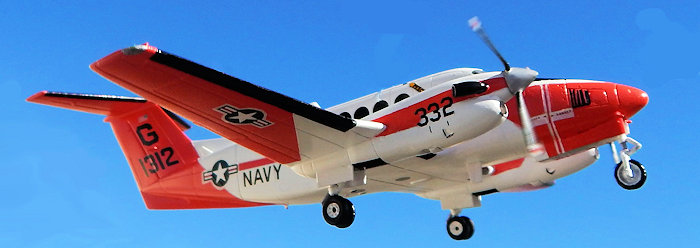 l surface
areas close to the joining line are covered with masking tape in order to
preserve during sanding of the filler at joining areas. Fuselage windows had
to be drilled at clear areas and shaped with sharp, pointed blade and
finish3ed with a smooth round file to produce exactly shaped round windows
at each side of fuselage.
l surface
areas close to the joining line are covered with masking tape in order to
preserve during sanding of the filler at joining areas. Fuselage windows had
to be drilled at clear areas and shaped with sharp, pointed blade and
finish3ed with a smooth round file to produce exactly shaped round windows
at each side of fuselage.
A particular item concerning the kit is that one nacelle after assembly was found to be 1/16” longer than the other. This was easily amended. Making the US Navy version shown on the box side view was a fairly straightforward job but there was no decal sheet available to complement the kit I had to look for an alternative version of the King Air with in view of solving the decal problem. My choice fell on C-12A of which I had one or two pictures and scale plans to refer to which to me proved sufficient.
The C-12A had the 3-blade props and as far as that goes was the
complete version I was building. The first stage of assembly was the
construction of the engine nacelles, open the front engine intakes, alter
the exhaust stack with alternative vac form parts that come with the kit and
bring the overall length of the nacelles equal. The 3-blade prop was then
added to each nacelle using super glue. The rest of assembly went step by
step. First shape and sand and assembling the wings, fuselage, detailing the
cockpit just like any previous vac form kit experience. Bearing in mind that
the kit has a front u/c and
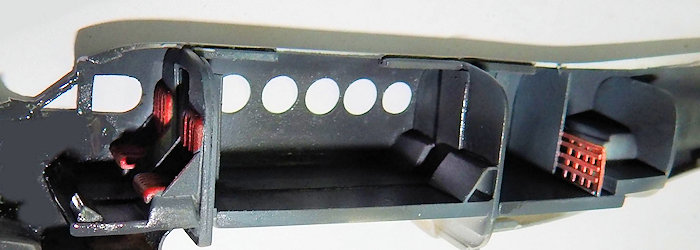 therefore needed balance weight to be added.
Reference was made to photos showing the interior of the type what looked
like a cargo compartment and passenger area. Plastic card was used to build
up the passenger/crew area before the attention was moved to detail the
two-crew cockpit area. A door was added to the forward bulkhead.
therefore needed balance weight to be added.
Reference was made to photos showing the interior of the type what looked
like a cargo compartment and passenger area. Plastic card was used to build
up the passenger/crew area before the attention was moved to detail the
two-crew cockpit area. A door was added to the forward bulkhead.
Other construction alterations included two large blade antennae, which were added to the fuselage, one to lower, and two on roof. These were made from backing sheet of styrene. An aerial made out of metal pin was added to the starboard wing leading edge. The white metal oleo and wheels were cleaned from the little flash present and fixed in place.
| COLORS & MARKINGS |
All the interior of wheel wells was painted white, while the oleo
legs were white with sliding parts silver. The model was given a first
overall coat of satin white. This has exposed some surface imperfections
that were then attended to. The kit was then given a final coat of white and
allowed 12 hours to dry. The kit
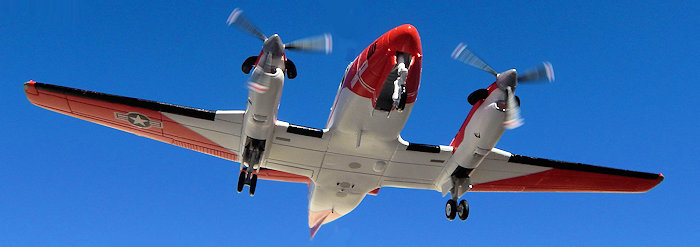 was then masked to apply the red/orange
areas on the wings and fuselage. The masking was carefully removed and a
striking colorscheme was starting to develop.
was then masked to apply the red/orange
areas on the wings and fuselage. The masking was carefully removed and a
striking colorscheme was starting to develop.
The next step was to paint the de icing boots, nose cone, and wheels, exhaust stacks; prop blades and anti glare panels on side of nacelle and front of canopy in semi matt black. A coat of floor wax was applied prior to fixing the decals. These were picked from my spares decal box luckily with slanting numbers and letters in black just the style that I sought for the Navy type I was building. A US national flag was carried on the tail fin.. The model was in the end given an overall coat of Alclad 2 Lacquer Klear Kote light sheen, while the wheels and anti glare panel areas in front of cockpit and sides of engine nacelles were coated in matt varnish. Last thing I did to the completed kit was adding thin film of Kristal Klear liquid to the window apertures.
| CONCLUSIONS |
This was another enjoyable build that was worth the extra effort to add detail to the kit. The type certainly appeals equally to both civil and military enthusiasts and once more I added a trainer aircraft that is used to train crew with twin turboprop engines for the future aviators to fly the Greyhound and Hawkeye Navy aircraft.
| REFERENCES |
Carmel J. Attard
February 2016
Copyright ModelingMadness.com
If you would like your product reviewed fairly and fairly quickly, please contact the editor or see other details in the Note to Contributors.